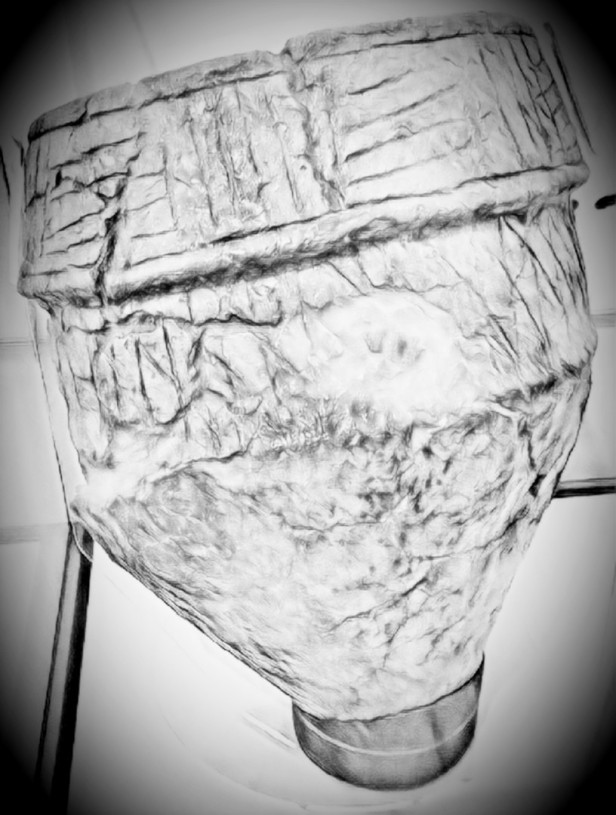In 1963, local farmer Peter Clitheroe was preparing the ground to erect a Dutch Barn at his farm next to Astley Hall. While using his tractor to remove a tree, his sharp eyes caught the sight of broken pottery amongst the tree roots. This turned out to be a Bronze Age burial urn. The find was noted, but the site was not properly excavated until 1974 when the new housing was being built at Astley Village.

The excavation took place over three years and was carried out by both the Chorley and West Lancashire Archaeological Societies, under the direction of professional archaeologist John Hallam. It was made difficult because of the proximity of farm building foundations and buried rubbish. However, the picture the archaeologists were able to assemble of the site is a fascinating one. It appears to have been a henge-like monument, consisting of a horseshoe-shaped ditch 36 feet in diameter, with wooden posts on the outside and inside, and ritual burials.
The Cremation Burials
Six cremation burials were discovered, but there may well have been more that were lost to the disturbance of a mechanical digger before the site was excavated. Two of the burials were in urns, and four others had been deposited straight into the ground in shallow pits. Variations in burial procedures like this is not uncommon, for example at nearby Noon Hill there are burials both in urns and without them.

Part of the original urn (U1) first discovered in 1963 was still in the ground at the time of excavation. It contained bones belonging to a female around 40 years old, who suffered from osteoarthritis. It is possible that bones from a second body were also present in this pot. Also inside the pot were a small burnt flint knife and an unburnt flake of igneous rock, probably of the type that was used to make axes in the Neolithic, which most likely came from the Lake District. The pot had three decorative techniques: the rim is marked with finger nail imprints, the collar had a ‘hurdle’ motif, and the neck displayed double chevrons and dots.
The second urn (U2) contained the bones of a child, around 7 years of age. Part of the left femur was stained green, which was probably caused by the breakdown of a decorative bronze pin. Fragments of a miniature collared urn and a small wooden bowl were also discovered, along with charcoal, soil and pebbles. The pot was buried upside down, which is not uncommon for this type of burial and may give a glimpse into the Bronze Age beliefs about the afterlife. (For a full discussion of how they viewed the deceased living in an underground mirror world, see our page on the Winter Hill Cairn here).

Two further cremations (C1 and C2) were found within the central part of the monument. The first could have come from two different bodies, and the second was of a child or young adolescent. A third and fourth set of cremations (C3 and C4) were found on the edge of the circular ditch, and these both appeared to have the bones deliberately broken after cremation.
Other Intriguing Finds
Just to the south of the entrance area was a pit in which was deposited 30 pieces of broken pottery, but although it was prehistoric, it was not of the collared urn type. Flints, charcoal and signs of burning were also discovered within the pit. The assemblage throws up more questions than answers, as it is not clear what its ritual significance was – but it would have had one.
Three further pits, two outside the monument and one inside, probably held upright timber posts. These were not part of a structure as such, but would have had a ritual significance.
Nearby to it were discovered two ‘rubbish pits’. This might seem odd to us in a modern day context, but often in prehistoric times rubbish from feasting would be buried at sacred sites, again, giving a significance only known to the Bronze Age people of the time.
Pieces of flint or chert were found across the henge-like monument, and within the immediate surrounding area and a little beyond. This indicates it was a site where stone tools were prepared, probably before it was a ritual site, as is Noon Hill.
The southern end of the monument was the entrance way, which had a cobbled area in front of it, suggesting it could have been a gathering place before any ritual was carried out within.

What Type of Monument Was This?
The word ‘henge’ is usually applied to a prehistoric monument which has a circular ditch. The most famous in Britain is Stonehenge, which leads people to think that all henges had stones around them. This is not the case – there is considerable variability, as some had wooden posts around them and some nothing at all. The monument that has the closest parallels to Astley Hall in Lancashire would be the double wood henge monuments at Bleasdale. This had a large number of wooden timbers encircling the site, whereas at Astley only three post holes were found. However, the disturbance to the site before excavation could have eradicated evidence of further posts. Henge-type monuments are rare in Lancashire, but there must be many others that lie undiscovered, just below the turf.
Site visited by A. and S. Bowden 2022
Access
The site is open access. An inscribed stone marks the site of the monument, which sits in front of Astley Hall Farm garden area, by the railings.
The urns are on display in the Astley Hall Visitors Centre which is free to enter.
Free parking in the Astley Village Car Park.
At the same site
References
The Surviving Past: archaeological finds and excavations in Central Lancashire, John Hallam (1988) Countryside Publications Limited
chorleyhistorysociety.co.uk/sys2013.htm
On site interpretation at the Astley Hall Visitors Centre
Comments are closed.